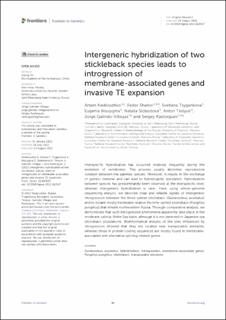| dc.contributor.author | Nedoluzhko, Artem | |
| dc.contributor.author | Sharko, Fedor | |
| dc.contributor.author | Tsyganova, Svetlana | |
| dc.contributor.author | Boulygina, Eugenia S. | |
| dc.contributor.author | Slobodova, Natalia | |
| dc.contributor.author | Teslyuk, Anton | |
| dc.contributor.author | Galindo-Villegas, Jorge | |
| dc.contributor.author | Rastorguev, Sergey | |
| dc.date.accessioned | 2022-08-29T07:29:46Z | |
| dc.date.available | 2022-08-29T07:29:46Z | |
| dc.date.created | 2022-07-20T10:21:00Z | |
| dc.date.issued | 2022 | |
| dc.identifier.citation | Nedoluzhko, A., Sharko, F., Tsygankova, S., Boulygina, E., Slobodova, N., Teslyuk, A., Galindo-Villegas, J. & Rastorguev, S. (2022), Intergeneric hybridization of two stickleback species leads to introgression of membrane-associated genes and invasive TE expansion. Frontiers in Genetics, 13:863547. doi: | en_US |
| dc.identifier.issn | 1664-8021 | |
| dc.identifier.uri | https://hdl.handle.net/11250/3013996 | |
| dc.description.abstract | Interspecific hybridization has occurred relatively frequently during the evolution of vertebrates. This process usually abolishes reproductive isolation between the parental species. Moreover, it results in the exchange of genetic material and can lead to hybridogenic speciation. Hybridization between species has predominately been observed at the interspecific level, whereas intergeneric hybridization is rarer. Here, using whole-genome sequencing analysis, we describe clear and reliable signals of intergeneric introgression between the three-spined stickleback (Gasterosteus aculeatus) and its primarily distant freshwater relative to the nine-spined stickleback (Pungitius pungitius) that inhabit northwestern Russia. Through comparative analysis, we demonstrate that such introgression phenomena occur in the moderate-salinity White Sea basin, although it is not detected in Japanese sea stickleback populations. Bioinformatical analysis of the sites influenced by introgression showed that they are located near transposable elements, whereas those in protein-coding sequences are primarily found in membrane-associated and alternative splicing-related genes. | en_US |
| dc.description.abstract | Intergeneric Hybridization of Two Stickleback Species Leads to Introgression of Membrane-Associated Genes and Invasive TE Expansion | en_US |
| dc.language.iso | eng | en_US |
| dc.publisher | Frontiers | en_US |
| dc.rights | Navngivelse 4.0 Internasjonal | * |
| dc.rights.uri | http://creativecommons.org/licenses/by/4.0/deed.no | * |
| dc.title | Intergeneric Hybridization of Two Stickleback Species Leads to Introgression of Membrane-Associated Genes and Invasive TE Expansion | en_US |
| dc.title.alternative | Intergeneric Hybridization of Two Stickleback Species Leads to Introgression of Membrane-Associated Genes and Invasive TE Expansion | en_US |
| dc.type | Peer reviewed | en_US |
| dc.type | Journal article | en_US |
| dc.description.version | publishedVersion | en_US |
| dc.rights.holder | © 2022 The Authors | en_US |
| dc.subject.nsi | VDP::Matematikk og Naturvitenskap: 400::Basale biofag: 470::Genetikk og genomikk: 474 | en_US |
| dc.subject.nsi | VDP::Matematikk og Naturvitenskap: 400::Zoologiske og botaniske fag: 480::Zoofysiologi og komparativ fysiologi: 483 | en_US |
| dc.subject.nsi | VDP::Matematikk og Naturvitenskap: 400::Basale biofag: 470::Bioinformatikk: 475 | en_US |
| dc.source.pagenumber | 15 | en_US |
| dc.source.volume | 13 | en_US |
| dc.source.journal | Frontiers in Genetics | en_US |
| dc.identifier.doi | 10.3389/fgene.2022.863547 | |
| dc.identifier.cristin | 2038879 | |
| dc.source.articlenumber | 863547 | en_US |

